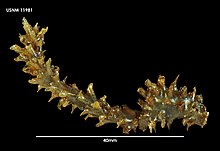Pterobranchia
| Pterobranchia Temporal range:
| |
|---|---|

| |
| Cephalodiscus nigrescens (collected from the Weddell Sea) | |
| Scientific classification | |
| Domain: | Eukaryota |
| Kingdom: | Animalia |
| Phylum: | Hemichordata |
| Class: | Pterobranchia Lankester 1877 |
| Orders | |
| |
| Synonyms | |
| |
Pterobranchia, members of which are often called pterobranchs, is a
The class Pterobranchia was established by
Electron microscope studies have suggested that pterobranchs belong to the same clade as the extinct graptolites,[1][2] and phylogenetic analysis suggests that the pterobranchs are living members of the graptolite clade.[3][4]
Biology
Pterobranchs are small worm-like
The collar bears a number of large arms, each of which includes a row of tentacles along one side. The number of arms varies between species, with anything from one to nine pairs. The tentacles are covered in cilia and aid in filtering food from the water. The trunk includes a simple tubular gut, and is curved over so that the
Development of pterobranchs have been studied only in
Evolution
Paleontology
The earliest pterobranchs, including
Taxonomy
Comparison of 18S ribosomal RNA sequences indicated that pterobranchs are closely related to enteropneust hemichordates.[17]
| Phylogeny of Pterobranchia[4] | |||||||||||||||||||||
|
Class Pterobranchia Lankester 1877[4]
- Subclass Cephalodiscida Fowler 1892 stat. nov.
- Order Cephalodiscida Fowler 1892
- Subclass GraptolithinaBronn 1849
- Order ?†CamaroideaKozlowski 1928 sensu Kozlowski 1949
- Order ?†CrustoideaBulman 1970
- Order ?†DithecoideaObut, 1960
- Order ?†TuboideaKozlowski 1938 sensu Kozlowsk 1949
- Order Rhabdopleurida Fowler 1892 sensu Beklemishev 1951
- Clade †Eugraptolithina Mitchell et al., 2013
- Order †DendroideaNicholson 1872
- Order †GraptoloideaMaletz, Carlucci and Mitchell 2009
- Order †
- Order ?†
Genomics
Genetic code
The two pterobranch taxa
| Genetic code | Translation table |
DNA codon | RNA codon | Translation with this code |
Standard translation | |||
|---|---|---|---|---|---|---|---|---|
| Pterobranchia mitochondrial | 24 | AGA |
AGA |
Ser (S) |
Arg (R)
| |||
AGG |
AGG |
Lys (K) |
Arg (R)
| |||||
TGA |
UGA |
Trp (W) |
STOP = Ter (*)
| |||||
| Cephalodiscidae mitochondrial | 33 | AGA |
AGA |
Ser (S) |
Arg (R)
| |||
AGG |
AGG |
Lys (K) |
Arg (R)
| |||||
TGA |
UGA |
Trp (W) |
STOP = Ter (*)
| |||||
TAA |
UAA |
Tyr (Y) |
STOP = Ter (*)
| |||||
Amino acids biochemical properties
|
nonpolar | polar | basic | acidic | Termination: stop codon |
References
- .
- ISBN 978-0-375-40119-0.
- .
- ^ ISSN 1214-1119.
- ^ ISBN 978-0-03-056747-6.
- ISBN 9781118515617.
- PMID 27701429.
- S2CID 84014156.
- S2CID 86563917.
- .
- .
- PMID 18798243.
- ^ Hemichordate Nervous System
- .
- PMID 21439828.
- doi:10.1130/G39788.1.
- PMID 7620637.
- PMID 21599892.
- PMID 30476024.
External links
- This article incorporates text from a publication now in the public domain: Chisholm, Hugh, ed. (1911). "Pterobranchia". Encyclopædia Britannica (11th ed.). Cambridge University Press.
- Cameron, Christopher B. (2016). A comprehensive list of extant hemichordate species with links to images
- Swalla Billie J. (2007). Class Pterobranchia
